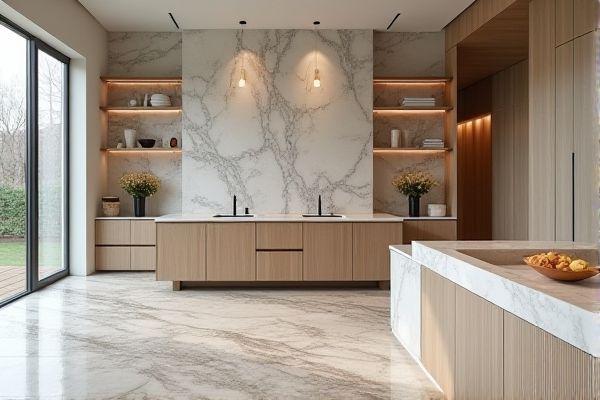
Quartzite offers natural stone durability and unique patterns, while engineered quartz provides consistent design, low maintenance, and a wider color range. Explore the article to discover which material best suits your kitchen or bathroom needs.
Table of Comparison
| Feature | Quartzite | Engineered Quartz |
|---|---|---|
| Material Type | Natural metamorphic rock | Man-made composite of quartz crystals & resin |
| Durability | Highly durable & heat resistant | Durable but less heat resistant |
| Appearance | Natural veining and unique patterns | Consistent color & pattern options |
| Porosity | Low porosity, naturally stain-resistant | Non-porous and stain-resistant |
| Maintenance | Requires occasional sealing | No sealing required, easy to clean |
| Cost | Generally higher due to natural sourcing | Moderate, varies by brand & design |
| Environmental Impact | Natural stone, quarrying impacts | Manufactured, uses resins and energy |
Introduction to Quartzite and Engineered Quartz
Quartzite is a natural metamorphic rock formed from sandstone subjected to high heat and pressure, known for its durability and unique veining patterns. Engineered quartz combines natural quartz crystals with resins and pigments to create a non-porous, low-maintenance surface available in a wide range of colors and patterns. Choosing between quartzite and engineered quartz depends on your preference for natural stone aesthetics versus consistent appearance and easier upkeep.
Composition and Formation
Quartzite is a natural metamorphic rock formed from pure quartz sandstone subjected to intense heat and pressure, resulting in a dense, durable material composed almost entirely of quartz crystals fused together. Engineered quartz is a man-made composite material consisting of approximately 90-95% ground natural quartz combined with resins, polymers, and pigments to create a non-porous, uniform surface. The significant difference in formation processes--natural geological metamorphism versus industrial manufacturing--affects their structural properties and aesthetic consistency.
Appearance and Aesthetics
Quartzite features natural stone patterns with unique veining and color variations that create an elegant, organic look ideal for high-end countertops. Engineered quartz offers consistent, uniform patterns and a wide range of customizable colors and finishes, providing more versatility for matching modern design aesthetics. Both materials provide a polished, glossy surface, but quartzite's natural texture contrasts with engineered quartz's controlled, manufactured appearance.
Durability and Hardness
Quartzite is a natural stone formed from sandstone subjected to intense heat and pressure, resulting in exceptional durability and a Mohs hardness of 7, making it highly resistant to scratches and heat. Engineered quartz, composed of approximately 90% natural quartz combined with resins and pigments, offers comparable hardness around 7 but is more flexible due to its resin content, enhancing impact resistance and reducing brittleness. Both materials provide excellent durability for countertops, but quartzite typically outperforms in heat resistance, while engineered quartz provides uniformity and stain resistance.
Maintenance and Care Requirements
Quartzite requires regular sealing to maintain its resistance to stains and moisture, making its upkeep more intensive compared to engineered quartz. Engineered quartz is non-porous and highly resistant to scratches and stains, needing only routine cleaning with mild soap and water. Both materials benefit from avoiding harsh chemicals and abrasive pads to preserve their surface integrity.
Cost Comparison
Quartzite typically costs between $70 and $100 per square foot, reflecting its natural stone origin and durability, while engineered quartz ranges from $50 to $80 per square foot due to its manufactured composition and consistent availability. Your choice may depend on budget priorities, as quartzite's higher price often corresponds to unique, natural patterns, whereas engineered quartz offers cost-effective options with uniform designs. Considering installation and maintenance costs, engineered quartz can provide better long-term value for homeowners seeking affordability without sacrificing quality.
Installation Process
Quartzite installation requires professional expertise due to its natural stone characteristics, involving precise cutting and sealing to prevent damage and enhance durability. Engineered quartz offers a more straightforward installation process with pre-fabricated slabs that simplify cutting and fitting, often allowing for quicker setup. Both materials demand proper adhesive and sealing techniques to ensure longevity and resistance to stains.
Environmental Impact
Quartzite is a natural stone formed through heat and pressure, offering a minimal environmental footprint due to its extraction and limited processing. Engineered quartz, composed of natural quartz fused with resins and pigments, has a higher environmental impact because of the energy-intensive manufacturing and the presence of synthetic materials. Your choice between these surfaces can influence sustainability efforts, favoring quartzite for a more eco-friendly option.
Common Applications in Interior Design
Quartzite is popular in high-end kitchen countertops and bathroom vanities due to its natural stone durability and unique veining patterns. Engineered quartz is widely used for kitchen islands, backsplashes, and commercial interiors because of its non-porous surface and extensive color options. Both materials enhance modern interior design by combining aesthetic appeal with functional performance.
Pros and Cons of Quartzite vs Engineered Quartz
Quartzite is a natural stone prized for its exceptional durability, heat resistance, and unique veining, making it ideal for high-traffic kitchen countertops but requires regular sealing to prevent staining. Engineered quartz offers uniform appearance, superior stain and scratch resistance, and low maintenance due to its non-porous surface, though it can be less heat-resistant and more prone to discoloration from prolonged UV exposure. Choosing between quartzite and engineered quartz depends on the balance between natural aesthetics and maintenance preferences versus consistent performance and ease of care.
 homyna.com
homyna.com